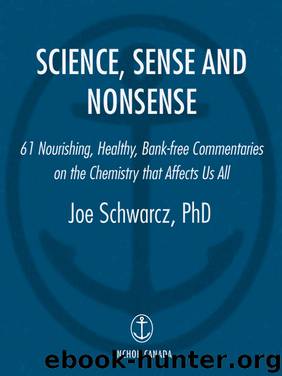Science, Sense & Nonsense by Dr. Joe Schwarcz

Author:Dr. Joe Schwarcz [Schwarcz, Joe]
Language: eng
Format: epub
ISBN: 978-0-307-37464-6
Publisher: Doubleday Canada
Published: 2008-12-31T16:00:00+00:00
NEW, IMPROVED DETERGENT
WALMART DOES NOT WANT nonylphenol ethoxylates (NPEs) in any of the products it sells. And when Walmart speaks, chemical suppliers listen. NPEs are excellent detergents, and for decades they quietly went about doing their job without garnering much attention. But evidence is mounting that when released into the environment they can break down into compounds that mimic the action of the hormone estrogen. Given an apparent worldwide decline in sperm quality, an increase in hormone-driven cancers and a decline in the age at which young women begin menstruating, any substance that has hormone-like effects becomes a concern. A cleaning product without NPEs would therefore be regarded as safer and “greener.” Like many other companies, Walmart is wading into the green waters. Whether this is because of a true environmental consciousness or because of visions of increased profits doesn’t really matter. Walmart’s stated goal of having its suppliers find substitutes for twenty “chemicals of concern” will benefit the environment and, possibly, human health.
This is not the first time that an ingredient in detergents has run into an environmental problem. Until the Second World War, doing the laundry meant using soap. It cleaned well, as long as conditions were right—water couldn’t be too acidic and couldn’t contain high levels of magnesium, calcium or iron, the “hardness” minerals. In an acid solution, soaps are converted to fatty acids, which are insoluble and which separate as a greasy scum; in hard water, soap forms an insoluble curd as it reacts with the minerals. The chemical challenge, then, was to develop a substance that cleaned like soap but didn’t have soap’s pitfalls. Enter the synthetic detergents, or “syndets.” Alkylbenzenesulphonates (ABSs), made from petroleum products, were molecules that, like soap, had a water-soluble end and a fat-soluble end. One end would anchor itself in a greasy stain, while the other was attracted to water. Essentially, the detergent formed a connection between the stain and water, allowing oily residues to be lifted from fabrics.
Alkylbenzenesulphonates quickly displaced soap in laundry products, and for about a decade both consumers and the detergent industry revelled in the clever chemistry that had solved a significant cleaning problem. And then the ABS story took a sour turn. Copious suds began to appear in sewage treatment plants as well as in some lakes and rivers. On occasion, people even got a head of foam when they drew a glass of water from their taps. What was going on? It didn’t take long for researchers to discover that naturally occurring micro-organisms that were very adept at breaking down soap molecules were stymied by the newfangled petroleum derivatives. The problem was the specific molecular structure of the ABSs. These molecules, like soap, had a long chain of carbon atoms; but unlike soap, they also had some carbon atoms hanging like branches from the main chain. Microbial enzymes couldn’t handle these branched-chain ABSs, and they began to build up in the environment—hence the suds. A solution was needed.
If the problem was caused by the
Download
This site does not store any files on its server. We only index and link to content provided by other sites. Please contact the content providers to delete copyright contents if any and email us, we'll remove relevant links or contents immediately.
Alchemy and Alchemists by C. J. S. Thompson(2912)
The Elements by Theodore Gray(2432)
The Club by A.L. Brooks(2360)
How to Make Your Own Soap by Sally Hornsey(2339)
Drugs Unlimited by Mike Power(2192)
Wheels of Life by Anodea Judith(1609)
Cracking the Sat French Subject Test, 2013-2014 Edition by The Princeton Review(1521)
The Cosmic Machine: The Science That Runs Our Universe and the Story Behind It by Scott Bembenek(1479)
Perfume by Jean-Claude Ellena(1472)
The Flavor Matrix by James Briscione(1363)
1000 Multiple-Choice Questions in Organic Chemistry by Organic Chemistry Academy(1353)
Cracking the LSAT, 2012 Edition by Princeton Review(1346)
MCAT Physics and Math Review by Princeton Review(1304)
Cracking the SAT Premium Edition with 6 Practice Tests, 2017 by Princeton Review(1252)
Synchrotron Light Sources and Free-Electron Lasers by Eberhard J. Jaeschke Shaukat Khan Jochen R. Schneider & Jerome B. Hastings(1236)
Handbook of Modern Sensors by Jacob Fraden(1225)
A is for Arsenic: The Poisons of Agatha Christie (Bloomsbury Sigma) by Kathryn Harkup(1214)
Harry Potter All Books: 8 Books by J.k.rowling(1189)
Cracking the AP English Language & Composition Exam, 2018 Edition by Princeton Review(1032)
